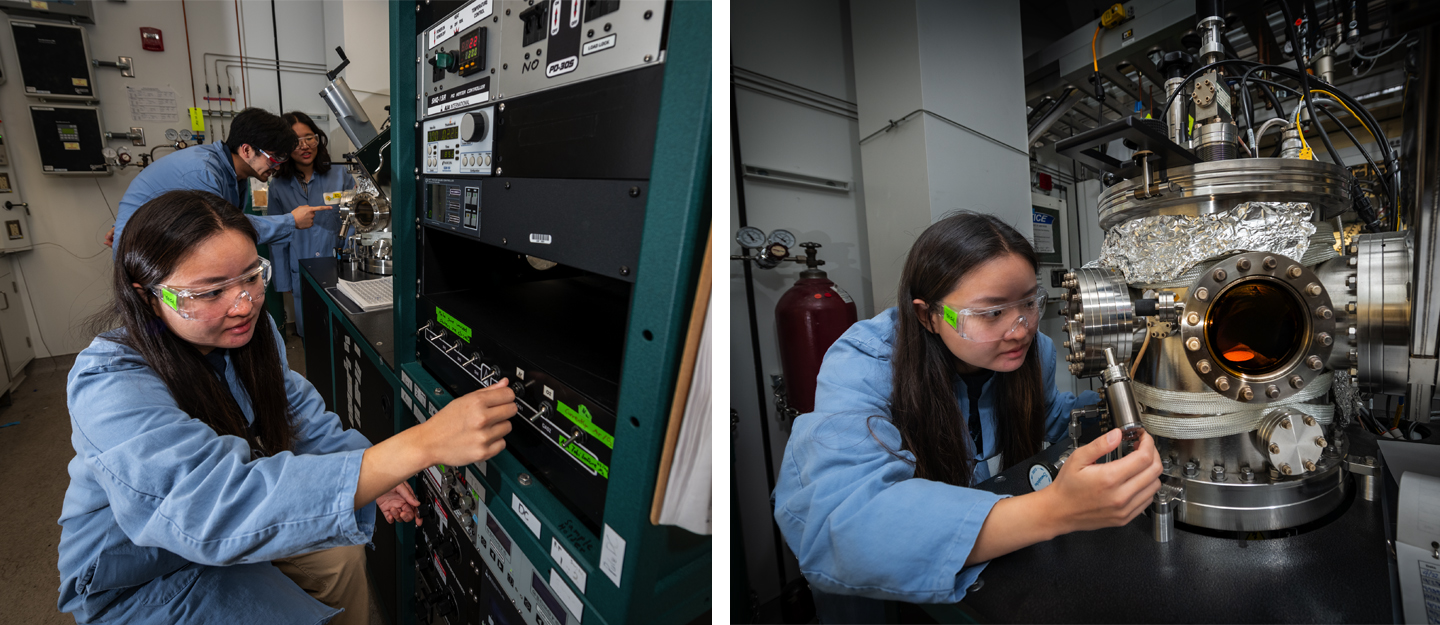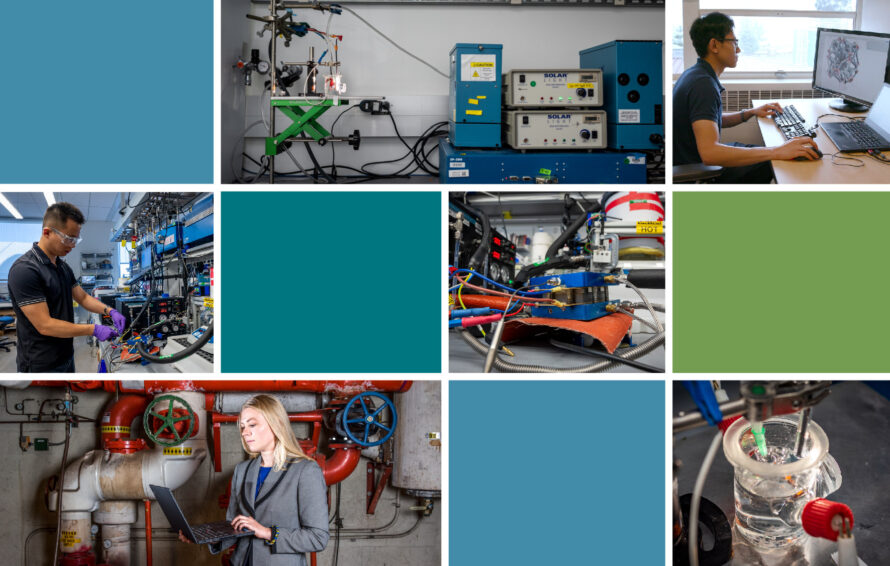Artificial photosynthesis could one day harness energy from the sun to convert carbon dioxide, nitrogen, and water into liquid fuels to power your car, and enable a process for creating chemicals and fertilizers that is better for the environment. But scientists first need new techniques to efficiently convert sunlight into solar fuels and chemicals at scale, and store them for later use.
Since its founding in 2020, the Liquid Sunlight Alliance (LiSA) – a Fuels from Sunlight Energy Innovation Hub funded by the U.S. Department of Energy – has made advances in developing the science principles by which liquid fuels can be generated from sunlight, carbon dioxide, and water.
“LiSA is bringing solar fuels closer to reality. In just five years our researchers have achieved major milestones in artificial photosynthesis.”
– Joel Ager, senior scientist and LiSA program lead at Berkeley Lab
Led by Caltech in close partnership with Lawrence Berkeley National Laboratory (Berkeley Lab), LiSA brings together more than 100 scientists from national lab partners at SLAC National Accelerator Laboratory and the National Renewable Energy Laboratory, and university partners at UC Irvine, UC San Diego, and the University of Oregon. This multi-institutional collaboration is focused on accelerating advances in solar fuels research by combining computationally driven experimentation with real-time observations using ultrafast X-rays and other advanced imaging techniques. By facilitating a national network of leading research capabilities, advanced instruments, and cutting-edge user facilities that are unique to national labs and universities, LiSA is paving the way for a solar fuels future.
“LiSA is bringing solar fuels closer to reality,” said Joel Ager, a senior scientist in Berkeley Lab’s Chemical Sciences Division who manages the Northern California LiSA facility at Berkeley Lab. “In just five years our researchers have achieved major milestones in artificial photosynthesis, from new materials and devices that convert sunlight and carbon dioxide into ethylene and other chemical fuels, to advances in computer modeling, data visualization, and X-ray imaging techniques that could make the conversion process more efficient and durable at the commercial scale.”
Here are five potential breakthroughs LiSA research teams led by Berkeley Lab have achieved so far.

1. Made solar energy available 24/7
Photoelectrochemical devices use sunlight to trigger chemical reactions that convert CO2 and water into liquid fuels. This artificial photosynthesis technology has the potential to revolutionize our energy infrastructure, but current photoelectrochemical techniques in CO2 reduction are limited by sluggish chemical processes and high energy requirements. A project led by Peidong Yang, a senior faculty scientist in Berkeley Lab’s Materials Sciences Division, offers an alternative approach: A new system design that is far less energy-demanding than conventional systems. This new design enabled 24/7 operation over multiple days – and effectively eliminated sunlight intermittency issues – by using silicon nanowire components that can be illuminated by renewably powered and superefficient LEDs.
2. Modeled artificial photosynthesis at multiple scales
Photoelectrochemical systems have the potential to produce hydrogen fuel and other liquid fuels through artificial photosynthesis, but manufacturing these fuels at scale will require improved efficiencies and product purity. In recent projects led by Adam Weber, senior scientist and head of the Energy Conversion Group in Berkeley Lab’s Energy Technologies Area, and Alexis Bell, faculty senior scientist in the Chemical Sciences Division, researchers developed and ran models to simulate how molecules, atoms, and electrons move around inside and at the interface of a photoelectrochemical device. These simulations shed light on the importance of ion transport – the movement of charged particles – in membrane materials and catalyst performance. The work also advanced new approaches to designing photoelectrochemical assemblies, including metal-insulator-semiconductor architectures, for CO2 reduction.

3. Clarified the fundamentals of corrosion: How are ions born?
A project led by Shannon Boettcher, a senior faculty scientist in Berkeley Lab’s Energy Storage & Distributed Resources Division, and Martin Head-Gordon, a senior faculty scientist in Berkeley Lab’s Chemical Sciences Division, has created a validated molecular model which accurately delineates the rates at which ions – chemical species that carry electrical current in solutions – are created when a material rusts and dissolves. The advance will help researchers understand the fundamentals of corrosion in photoelectrochemical devices, a longstanding challenge to the commercialization of artificial photosynthesis. The model also maps out the rates at which ions are consumed at the interface between a solid and a liquid, such as when metals are plated from a solution to fabricate semiconductor chips.
By combining laboratory experiments with leading-edge computation, the team’s collaborative study revealed the sequence of molecular events and the resulting barriers that control how fast ions can be formed or consumed. The researchers are currently expanding the approach to complex systems: The aim is to create a general theory that is of broad importance to electrochemical technology in renewable liquid fuel synthesis, batteries, and controlling corrosion processes.
The experimental work was completed at the University of Oregon, a partnering LiSA institution where Boettcher was a chemistry and biochemistry professor before joining Berkeley Lab.
4. Developed superfast X-ray techniques to observe a cutting-edge catalyst at work in real time
Copper is one of the best catalysts in artificial photosynthesis for converting CO2 into liquid fuels like ethanol, ethylene, and propanol. Researchers have wanted to improve the efficiency and product yield of these reactions, but observing them under operando or real-world working conditions at the interface between metal and electrolyte has been a challenge. A project led by Junko Yano, a senior scientist and Molecular Biophysics & Integrated Bioimaging Division Director at Berkeley Lab, could enable the operando characterization of chemical reactions that take place where metal and electrolyte meet. Using X-ray beamlines at SLAC’s Stanford Synchrotron Radiation Lightsource and Berkeley Lab’s Advanced Light Source, the team is developing and applying techniques to determine where chemical reactions take place in active sites of a copper-liquid interface at relevant time scales. The work can enable new insight related to the catalytic mechanism and durability issues in artificial photosynthesis systems.

5. Discovered new materials for solar-driven CO2 conversion to fuels and chemicals
Photoelectrochemical devices for solar fuels applications rely on the reactions occurring on semiconductor surfaces under illumination. However, many otherwise promising semiconductors are not conducive for the desired CO2 reduction chemistry due to underperformance in chemical stability and selectivity. Recent work by Joel Ager and his research team discovered two ways to overcome these challenges. First, they showed that an appropriately chosen metal oxide film can both protect the semiconductor from corrosion while allowing electrons to flow to a catalyst, allowing for solar-driven synthesis of ethylene from CO2.
Next, his team showed that Cu(InGa)S2 or CIGS – a material used in the photovoltaic industry, but previously overlooked for solar fuels – can convert CO2 to chemicals like carbon monoxide and formic acid all by itself, without any need for protective coatings or co-catalysts. This work was in collaboration with teams from imec Belgium and the Advanced Light Source at Berkeley Lab. These breakthroughs point to the vast potential of solar-driven CO2 conversion and open new research avenues for exploration.
This work was supported by the DOE Office of Science.

###
Lawrence Berkeley National Laboratory (Berkeley Lab) is committed to delivering solutions for humankind through research in clean energy, a healthy planet, and discovery science. Founded in 1931 on the belief that the biggest problems are best addressed by teams, Berkeley Lab and its scientists have been recognized with 16 Nobel Prizes. Researchers from around the world rely on the Lab’s world-class scientific facilities for their own pioneering research. Berkeley Lab is a multiprogram national laboratory managed by the University of California for the U.S. Department of Energy’s Office of Science.
DOE’s Office of Science is the single largest supporter of basic research in the physical sciences in the United States, and is working to address some of the most pressing challenges of our time. For more information, please visit energy.gov/science.



